Builders' Forum |
|
| ↓ Scroll to Last Comment ↓ | Forum Guidelines | Builders' Forum | |
Pegs/Trunnels vs Screws for shear forces
About to start building a new Passagemaker. Was wondering whether it might work, be stronger, and possibly look better to use dowel pegs / trunnels (though without the wedge) to replace screws, where feasible and where the purpose of the screws is to protect against shear forces.
For example, consider the places where the instructions call for screws through the hull attaching the mast step, or the skids, skeg, etc. The plan is, rather than using screws, drill 1/2" or 1/4" holes as appropriate for the piece and pound in wood dowels dipped in epoxy, then cut them flat with the japanese saw.
It seems like the shear strength on this would be greater than on a brass screw. Though maybe the screws are strong enough that it's not really a concern anyway. Additionally, though the grain would be different, perhaps the dowel, being wood, would expand/contract at a closer rate to the plywood (closer than screws, that is); so that the stress fractures caused by metal fastners would be reduced (if not eliminated).
Any thoughts / warnings appreciated!
15 replies:
RE: Pegs/Trunnels vs Screws for shear forces
Erik,
I'd skip the fasteners entirely. I have a 12-ft dinghy whose skeg is bonded to its bottom. No screws, no holes. The mast step is bedded in epoxy/woodflour putty. I also have a schooner that is half-again as long as the PD and has half-again the sail area. No screws for that boat, either.
Birch2's point about clamping is a good one, but fortunately thickened epoxy doesn't nee strong clamping forces, so you can get creative with tape.

I also used tape to hold the skeg in place while the epoxy set, then made some nice fillets (which distribute the stress and smooth the water flow) and covered them with glass tape. That skeg hasn't moved in 8 years.
Pegs and trunnels would definitely work and they would distribute the stresses much better than metal fasteners (and look good for a bright finish).
So, it's your boat, pick the one you like best. Either way you'll have a nice boat.
Laszlo
RE: Pegs/Trunnels vs Screws for shear forces
This is a question that has been on my mind for a good while, in the event I ever take on a big boat project. It seems the first major event in the life of a well maintained wooden boat of any size is that she will need to be "refastened" after about 40 years. I wonder why she couldn't just be fastened with pegs and epoxy to begin with and skip the whole refastening problem.
Hooper
RE: Pegs/Trunnels vs Screws for shear forces
Well, a very short google search reveals this is not a new idea at all and maybe the epoxy is not even necessary. It makes me wonder why metal fastenings ever came into vogue. I guess they make things go faster, especially in a production shop.
Hooper
RE: Pegs/Trunnels vs Screws for shear forces
Hooper,
Don't confuse stitch and glue with plank on frame.
Traditional plank on frame counts on the wood absorbing water and swelling. The forces generated by the swollen trunnels being squeezed by the swollen planks and frames create so much friction that the wood cannot move. But as soon as the wood dries out, most of this friction is lost. In that event, having mechanical fasteners to hold everything together until the wood swells again is a useful thing.
Once you start encapsulating the wood with epoxy, it doesn't swell or shrink, so you have to depend on either mechanical fasteners, bonding or a combination of the two methods. A bonded joint is stronger and stresses the boat less than a mechanically fastened joint. If you used trunnels without epoxy glue, you'd have to let them absorb water to swell, introducing a rot pathway. If you glued and epoxy coated the trunnels, there'd be no rot, but also very little point over a purely bonded joint.
Have fun,
Laszlo
RE: Pegs/Trunnels vs Screws for shear forces
I suppose we're beyond the scope of the CLC Builder's Forum here, but it's probably a good thought process for everyone. I'm not confusing stitch & glue with plank on frame. I'm wondering if there could be some overlap (no pun intended). If a large, traditional, wooden carvel planked boat was fastened with trunnels set in epoxy, it seems like they would hold in the same manner as metal fastenings without the eventual failure. (and probably a lot cheaper if you don't count the labor) The planks could still be caulked with cotton and would expand in the water as traditionally designed, the fastenings would be rigid and something else would fail before the fastenings. In a large boat that lives in the water, the same may be accomplished without the epoxy, at least below the waterline. Is there a fault in that logic?
Hooper
RE: Pegs/Trunnels vs Screws for shear forces
This is a great question which really speaks to the purist in me. In the example where I was adding the skeg, skids and mast base to the bottom of my Eastport Pram (which is just a smaller version of the PM), the silicon bronze screws I used acted as clamps to hold the solid oak tightly up against the bottom until the epoxy cured. I hadn't thought about removing them afterwards, but it's an interesting concept.
In my case, the solid, white oak skids were spring pretty severely to get them to conform to the shape of the rocker in the EP bottom. It was quite a trick to mount them into position with pre-drilled holes.
As usualy, my default or go-to answer is that there have been thousands of PMs built according to the manual, so I wouldn't stray too far from that unless you have a really good reason.
RE: Pegs/Trunnels vs Screws for shear forces
Hooper,
Interesting idea, traditional plank on frame secured with epoxied trunnels. My thought is that if you're not using the epoxy for waterproofing, you might as well use the cheaper waterproof glues, so that goes back to your earlier statement that "maybe the epoxy is not even necesary".
I have no idea if a glued trunnel would be any better than a plain one in traditional building. It could make repairs more difficult. Something to think about.
Laszlo
RE: Pegs/Trunnels vs Screws for shear forces
Following up to close the loop on this, with partial success and a lesson learned.
I decided to use trunnels / pegs to put together the mast step as an experiment. I. used a half inch dowel, sanded it smooth so it would fit, and drilled the holes loose. I put some epoxy-sawdust goop in the bottom (to fill the bottom of the hole) and also brushed onto the sides of the dowels. It pretty much all worked out, I'm happy with the result, and will be doing other joining operations using pegs where possible. Pictures below.
Four things I will do differently next time. First, in pounding in the dowels, I didn't know exactly how long I had drilled the holes. I tapped them until they stopped going in, hopefully that was far enough. I could have fixed this by cutting uniform length dowels and using a piece of tape or a collar on the drillbit.
Second, these dowels were probably a little bit too wide for the application. 1/4" dowels would have done the job and left more original wood and room for error.
Third, I think it would have been better to use unthickened, or cellulose thickened, epoxy to coat the pegs before putting them in the holes. The sawdust thickened epoxy, when squeezed into the tight space between the dowel and the hole, created too much friction.
Fourth, possibly related to several of the above, on one corner when I pounded in the dowel, the pine wood split outwards a little bit. Luckily the hole was full of goop so the cracks were filled up and cured nicely. Most likely candidate here is I just pounded the peg too far. But, while thinking about it, it occurred to me that the peg was sort of like a piston and there would be compressed air in the cavity (especially since the walls of the cavity were filled with epoxy goop, and that compressed air could have helped with the splitting. So next time I think I will use the saw to cut a little groove in the long side of the pegs, so that air or goop trapped at the bottom can escape out the top during peg insertion.
RE: Pegs/Trunnels vs Screws for shear forces
It turned out pretty well. Definitely the smaller pegs next time, but I bet this will last you the lifetime of the boat.
Laszlo
RE: Pegs/Trunnels vs Screws for shear forces
Following up here, I think I'm about 3/4 of the way through my metal-fastener-free PMD build, so far so good.
As usual, carefully reading and appreciating, and then failing to follow exactly everyone's good advice and instructions, I did not skip the fasteners as Laszlo suggested; and I did not follow the instructions in the book as CaptainSkully suggested, so if disaster strikes it is my own fault.
Following my experiment with the too-big-pegs that split the mast step side, I started using 1/4" oak dowels and drilling the holes with a 5/16" bit. The pegs wobble ever so slightly in the holes (until the epoxy cures but they just drop in so no pounding them and no more splitting parts.
I'm pretty happy with this method so far and I think i'll continue using it wherever possible. It takes a little bit more time than just using screws, but not really that much more -
So far I've used this fake-trunnels-sealed-in-epoxy method to fasten the below parts. I have left to fasten the mast step to the bottom, and also probably a few other things here and there, but I don't think I will have any metal fastners in the boat at the end, except for where other metal or plastic parts are designed to require them, e.g. oarlocks, cleats for lines, &c.
- The end of a spar that I split drilling a hole for the outhaul,
- The mast step as previously advertized,
- The daggerboard trunk to the bottom of the boat
- The skeg to the bottom of the boat
- The skids to the bottom of the boat.
RE: Pegs/Trunnels vs Screws for shear forces
After cutting apart the PMD I got the mast step fitted into place. Still no metal fasteners in this boat! I think the first metal that actually goes in will be the oarlock sockets.



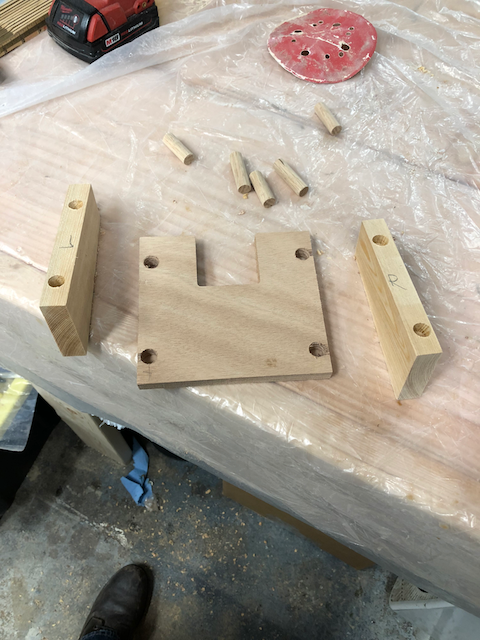
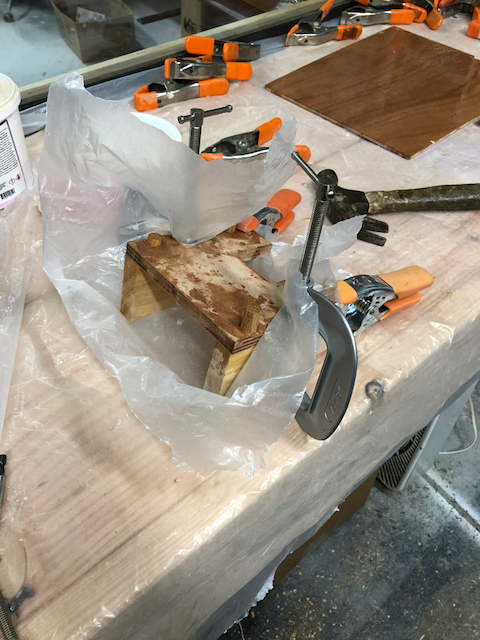
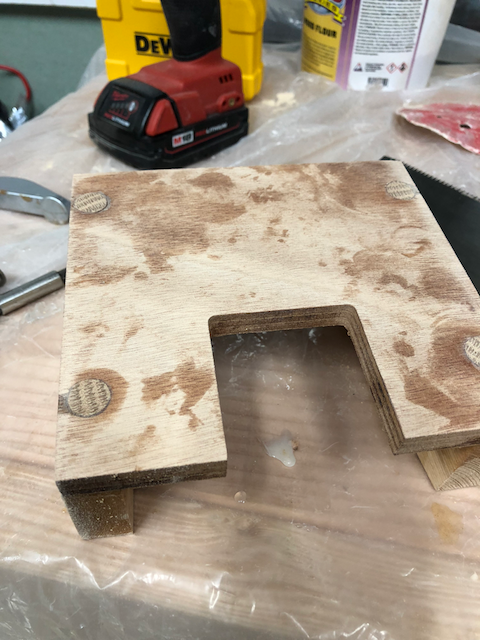
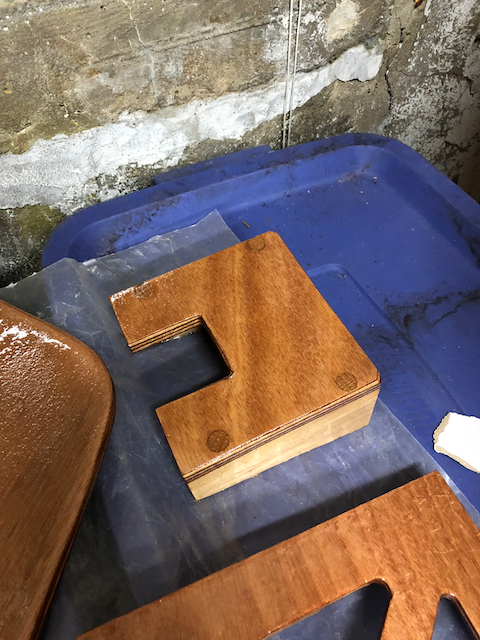
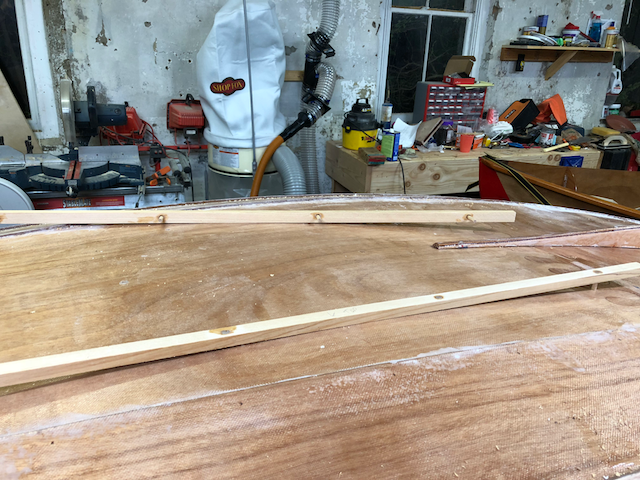
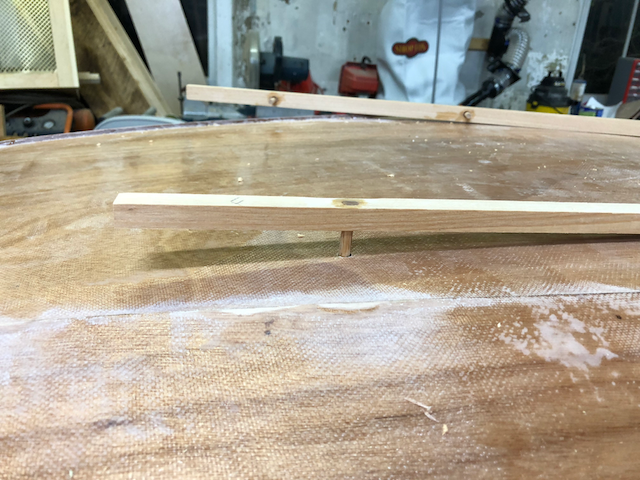
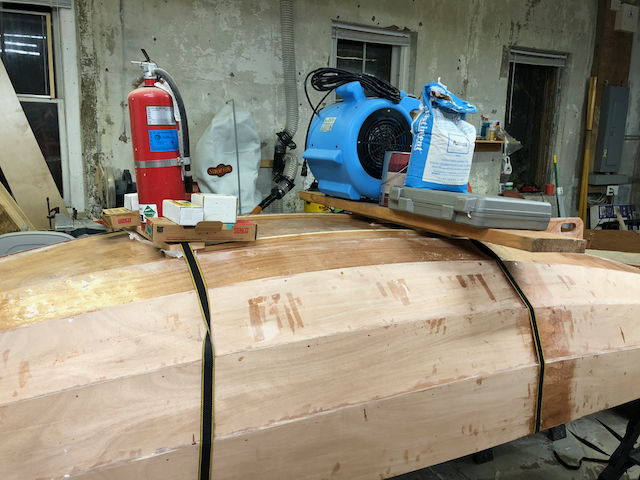
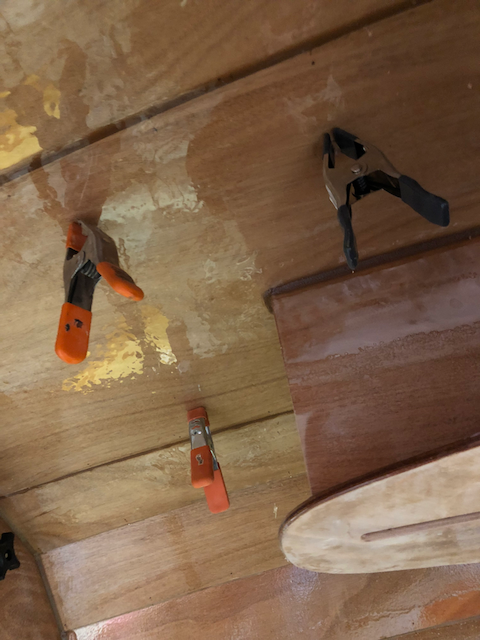
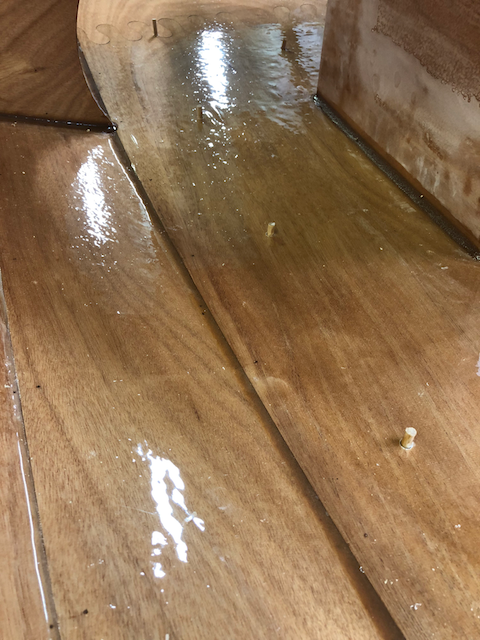
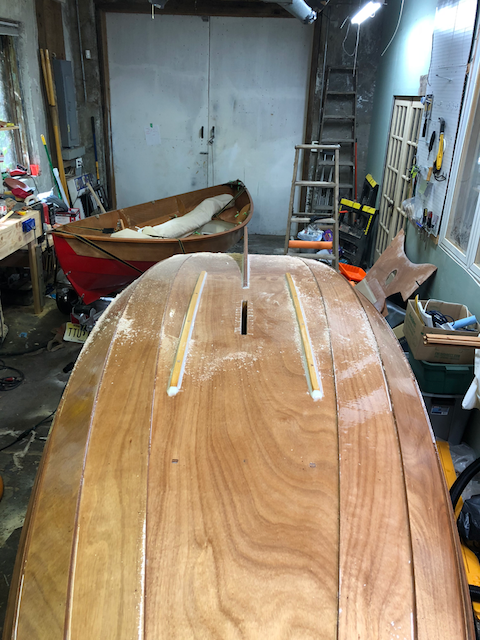
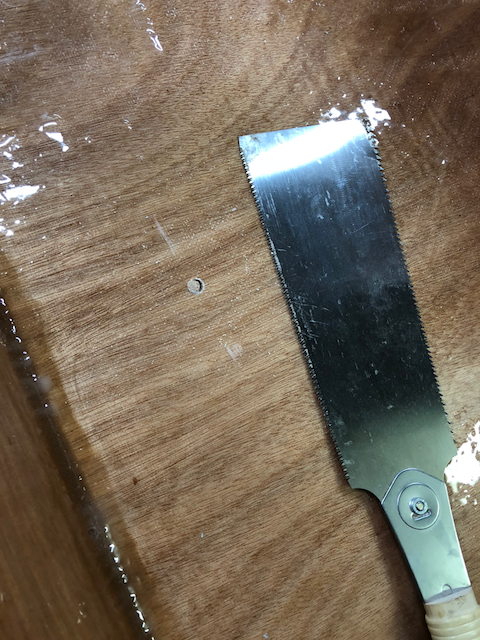
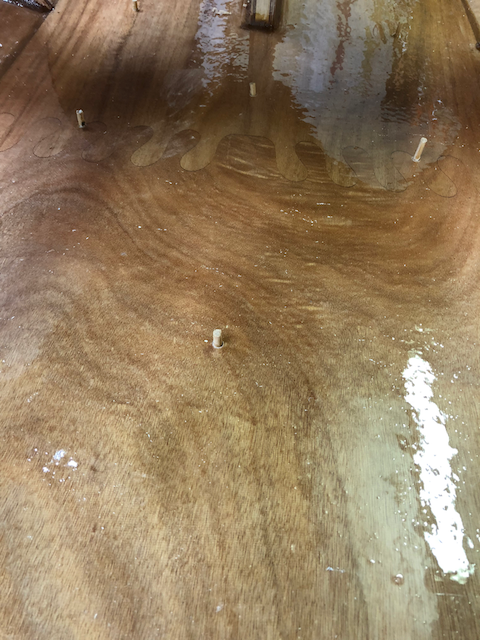












RE: Pegs/Trunnels vs Screws for shear forces
» Submitted by Birch2 - Tue, 10/10/17 » 4:51 PM
It seems to me that screws are used in places that would be hard to clamp. In nearly all cases I think they could be removed once the epoxy has set. Replacing them with dowels would look great. I think some builders just fill the holes with epoxy putty.